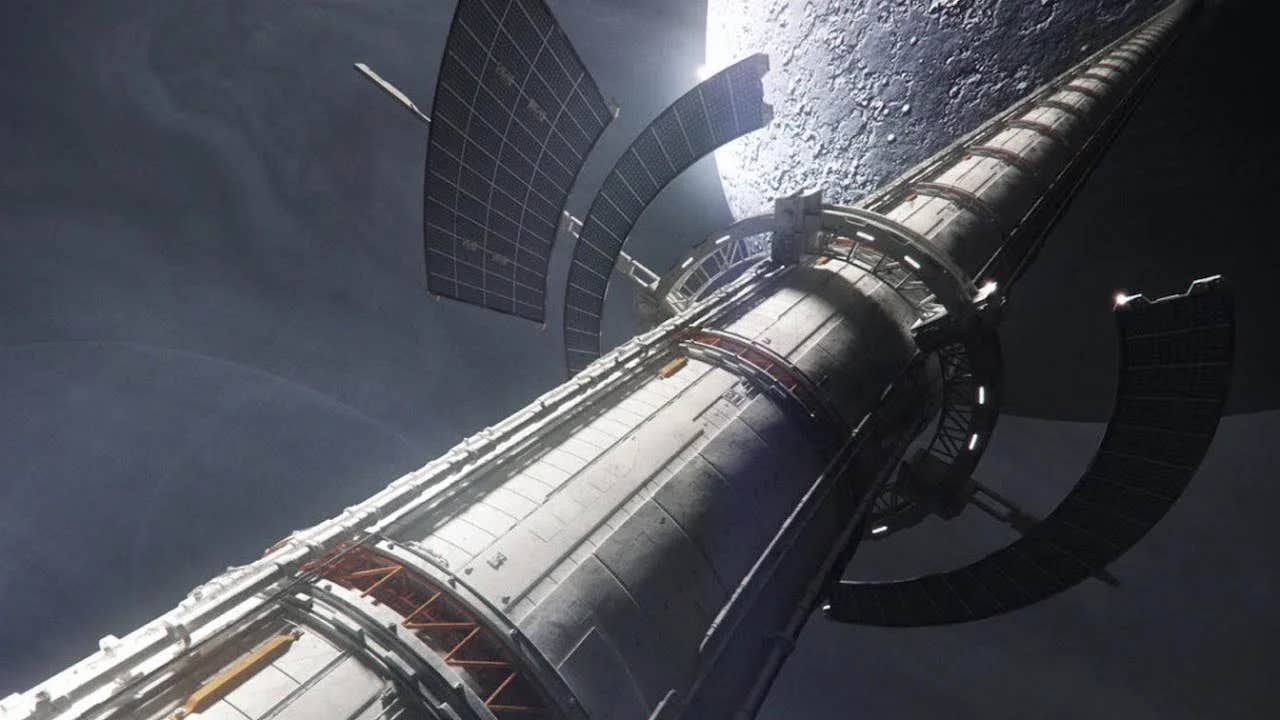Riding a space elevator to the Moon is possible using today’s technology
Scientists propose a lunar spaceline to cut costs and open new frontiers in space exploration, making interplanetary travel more accessible than ever.

A space elevator would use a cable stretching from Earth’s surface to beyond geostationary orbit—about 42,000 kilometers (26,098 miles) into space. (CREDIT: CC BY-SA 4.0)
For decades, the astronomical cost of overcoming Earth’s gravity has posed a significant barrier to space exploration. Launching just one kilogram into orbit can cost tens of thousands of dollars. These costs escalate dramatically for missions extending to the Moon and beyond.
Now, researchers Zephyr Penoyre of the University of Cambridge and Emily Sandford of Columbia University propose a groundbreaking solution: the “spaceline,” a conceptual lunar space elevator that could dramatically reduce the cost of space travel.
From Rockets to Elevators
Traditional rocket propulsion relies on expelling mass in one direction to generate thrust in the opposite. This process requires vast amounts of propellant, which adds to mission costs and complexity. For years, scientists and engineers have explored alternative methods to escape Earth’s gravity, and the idea of a space elevator has stood out as a promising concept.
A space elevator would use a cable stretching from Earth’s surface to beyond geostationary orbit—about 42,000 kilometers (26,098 miles) into space. Vehicles could climb this cable, powered by solar energy, eliminating the need for onboard fuel.
However, building such a structure is fraught with challenges. The cable must withstand immense tension, and existing materials, even the strongest carbon fiber polymers, fall short of the required strength.
The Spaceline Concept
Penoyre and Sandford offer a novel twist. Instead of anchoring the cable to Earth, they propose tethering it to the Moon and extending it toward Earth. This would take advantage of the Moon's slower orbital rotation and the gravitational equilibrium between the two celestial bodies.
Related Stories
At a critical point known as the Lagrange point, the gravitational pulls of Earth and the Moon cancel each other out. This region would serve as a pivotal part of the spaceline. Below the Lagrange point, Earth's gravity would pull the cable downward.
Above it, the Moon’s gravity would draw the cable upward. This setup significantly reduces the tension forces on the cable, making the concept viable with current high-strength materials like carbon polymers, including Zylon.
According to Penoyre and Sandford, these materials could support a cable extending from the Moon to geostationary orbit. Such a structure, with a diameter no greater than a pencil lead, could feasibly be constructed at a cost comparable to other large-scale space missions—around several billion dollars.
Engineering a New Era of Space Travel
Once built, the spaceline could revolutionize space travel. The researchers estimate that the fuel required to reach the Moon would drop to a third of current levels. This would open up unprecedented opportunities for lunar exploration and development.
Penoyre and Sandford highlight another critical advantage: the spaceline would provide safe access to the Lagrange point, an area with unique properties. “By extending a line, anchored on the Moon, to deep within Earth’s gravity well, we can construct a stable, traversable cable allowing free movement from the vicinity of Earth to the Moon’s surface,” they explain.
The Lagrange point’s low gravitational gradient makes it an ideal location for construction and maintenance of space infrastructure. Unlike low Earth orbit, where tools and equipment rapidly drift away, objects at the Lagrange point stay nearby for extended periods. Moreover, the region is relatively free of debris and meteoroids, reducing risks to space missions.
Unlocking the Lagrange Point’s Potential
The Lagrange point offers a stable platform for a variety of scientific and technological endeavors. Penoyre and Sandford envision it as a base camp for advanced experiments and missions. Potential projects could include space-based telescopes, particle accelerators, gravitational wave detectors, and power generation facilities. It could also serve as a launch station for deep-space missions.
“The Lagrange point has been mostly untouched by previous missions, and orbits passing through here are chaotic, greatly reducing the amount of meteoroids,” note the researchers. This untapped region could become the hub of future space exploration.
The spaceline would make frequent, cost-effective travel between Earth, the Lagrange point, and the Moon a reality. This could catalyze the development of a permanent human presence in space, enabling both scientific research and commercial ventures.
A Vision Within Reach
The spaceline isn’t merely a futuristic dream; it is a concept grounded in current technology. Penoyre and Sandford’s research shows that with materials and engineering techniques available today, humanity could take a significant leap toward establishing a permanent foothold in space.
While the initial investment would be substantial, the long-term benefits could transform space travel. Costs would plummet, and larger payloads could be transported efficiently. More importantly, access to new regions of space, including the Lagrange point, could accelerate scientific discovery and innovation.
By reducing the cost and complexity of reaching orbit and beyond, the spaceline could pave the way for a new era of space exploration. From lunar bases to interplanetary missions, the possibilities are vast. The spaceline isn’t just a solution to a technical challenge; it’s a gateway to the next frontier.
Note: Materials provided above by The Brighter Side of News. Content may be edited for style and length.
Like these kind of feel good stories? Get The Brighter Side of News' newsletter.
Joseph Shavit
Head Science News Writer | Communicating Innovation & Discovery
Based in Los Angeles, Joseph Shavit is an accomplished science journalist, head science news writer and co-founder at The Brighter Side of News, where he translates cutting-edge discoveries into compelling stories for a broad audience. With a strong background spanning science, business, product management, media leadership, and entrepreneurship, Joseph brings a unique perspective to science communication. His expertise allows him to uncover the intersection of technological advancements and market potential, shedding light on how groundbreaking research evolves into transformative products and industries.



